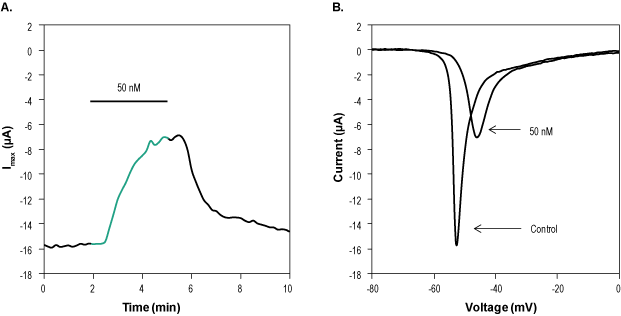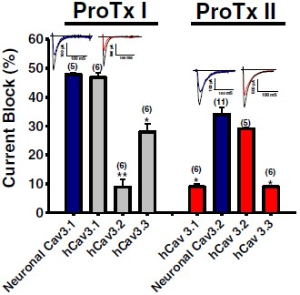Overview
Cat #:
STP-400
Alternative Name β-theraphotoxin-Tp1a, Beta-theraphotoxin-Tp1a, Protoxin-I, ProTx-1, Protoxin-1, ProTx I
Lyophilized Powder yes
Origin Synthetic peptide
MW: 3988 Da
Purity: >98% (HPLC)
Effective concentration 10-100 nM.
Sequence ECRYWLGGCSAGQTCCKHLVCSRRHGWCVWDGTFS.
Modifications Disulfide bonds between Cys2-Cys16, Cys9-Cys21, Cys15-Cys28.
Molecular formula C171H245N53O47S6.
CAS No.: 484598-35-8
Activity ProTx-I inhibits voltage-gated Ca2+ (CaV3.1), K+ (KV2.1), and all Na+ channels tested (NaV1.2, NaV1.5, NaV1.7 and NaV1.8). The toxin shifts the voltage-dependence of channel activation to more positive potentials.
Accession number P83480.
Shipping and storage Shipped at room temperature. Product as supplied can be stored intact at room temperature for several weeks. For longer periods, it should be stored at -20°C.
Solubility Any aqueous buffer. Centrifuge all product preparations before use (10000 x g 5 min).
Storage of solutions Up to two weeks at 4°C or three months at -20°C.
Our bioassay
 Alomone Labs ProTx-I inhibits NaV1.5 currents in stably transfected HEK293 cells.A. Time course of ProTx-I (#STP-400) action. Current amplitudes were plotted as a function of time. Holding potential was -100 mV and currents were stimulated every 10 seconds by a voltage ramp of 50 msec from holding potential to +60 mV. 50 nM ProTx-I was perfused in the period marked by the horizontal bar (green). B. Superimposed traces of NaV1.5 currents before and during 3 min application of 50 nM ProTx-I.
Alomone Labs ProTx-I inhibits NaV1.5 currents in stably transfected HEK293 cells.A. Time course of ProTx-I (#STP-400) action. Current amplitudes were plotted as a function of time. Holding potential was -100 mV and currents were stimulated every 10 seconds by a voltage ramp of 50 msec from holding potential to +60 mV. 50 nM ProTx-I was perfused in the period marked by the horizontal bar (green). B. Superimposed traces of NaV1.5 currents before and during 3 min application of 50 nM ProTx-I. Alomone Labs ProTx-I inhibits CaV3.1 channels expressed in Xenopus oocytes.A. Representative time course of ProTx-I (#STP-400) inhibition of CaV3.1 maximum current. Membrane potential was held at -100 mV, current was elicited by a 100 ms voltage step to -30 mV every 10 sec, and was significantly inhibited by application of 1 µM ProTx-I (top horizontal bar). B. Superimposed traces of CaV3.1 current following the application of control and of 1 µM ProTx-I (as indicated). Taken from experiment in A.
Alomone Labs ProTx-I inhibits CaV3.1 channels expressed in Xenopus oocytes.A. Representative time course of ProTx-I (#STP-400) inhibition of CaV3.1 maximum current. Membrane potential was held at -100 mV, current was elicited by a 100 ms voltage step to -30 mV every 10 sec, and was significantly inhibited by application of 1 µM ProTx-I (top horizontal bar). B. Superimposed traces of CaV3.1 current following the application of control and of 1 µM ProTx-I (as indicated). Taken from experiment in A. Alomone Labs ProTx-I inhibits NaV1.7 channel currents heterologously expressed in Xenopus oocytes.A. Representative time course of ProTx-I (#STP-400) inhibition of NaV1.7 channels current. Membrane potential was held at -100 mV, current was elicited by a 100 ms voltage step to -10 mV every 10 sec, and significantly inhibited by application of 250 nM ProTx-I (green).
Alomone Labs ProTx-I inhibits NaV1.7 channel currents heterologously expressed in Xenopus oocytes.A. Representative time course of ProTx-I (#STP-400) inhibition of NaV1.7 channels current. Membrane potential was held at -100 mV, current was elicited by a 100 ms voltage step to -10 mV every 10 sec, and significantly inhibited by application of 250 nM ProTx-I (green).
B. Superimposed traces of NaV1.7 channel currents in the absence (control) and presence (green) of 250 nM ProTx-I (taken from the recording in A).
Scientific background
Native ProTx-I has been isolated from the venom of the tarantula Thrixopelma pruriens. It was purified on the basis of its ability to reversibly inhibit the tetrodotoxin (TTX)-resistant Na channel NaV1.8. ProTx-I was also found to be an inhibitor of NaV1.5, NaV1.7 and NaV1.3 with IC50 values below 100 nM. Furthermore, ProTx-I shifts the voltage dependence activity of CaV3.1 (α1G) (IC50 ~50 nM) without affecting the voltage dependence of inactivation1,2. ProTx-I also blocks TRPA1 channel with an IC50 of 0.39 µM3.
Structurally, ProTx-I is shown to belong to the inhibitory cystine knot (ICK) family of peptidyl toxins interacting with voltage-gated ion channels.
Target NaV, CaV3.1, KV2.1, TRPA1 channels
Peptide Content: 100%
Lyophilized Powder
Image & Title 
Alomone Labs ProTx-I and ProTx-II inhibit T-type CaV channels.ProTx-I (#STP-400) was applied to mouse thalamic neurons and ProTx-II (#STP-100) was tested on mouse DRGs. ProTx-I blocks native mouse CaV3.1 channel and recombinant human CaV3.1 channel currents similarly, and blocks to a lesser extent CaV3.2 and CaV3.3 channel currents. ProTx-II blocks CaV3.2 channels more potently than the other T-type currents.Adapted from Bladen, C. et al. (2014) Mol. Brain 7, 36. with permission of BioMed Central.

Alomone Labs ProTx-I and ProTx-II inhibit T-type CaV channels.ProTx-I (#STP-400) was applied to mouse thalamic neurons and ProTx-II (#STP-100) was tested on mouse DRGs. ProTx-I blocks native mouse CaV3.1 channel and recombinant human CaV3.1 channel currents similarly, and blocks to a lesser extent CaV3.2 and CaV3.3 channel currents. ProTx-II blocks CaV3.2 channels more potently than the other T-type currents.Adapted from Bladen, C. et al. (2014) Mol. Brain 7, 36. with permission of BioMed Central.
For research purposes only, not for human use
Last Update: 08/01/2025
Specifications
Citations
Citations

